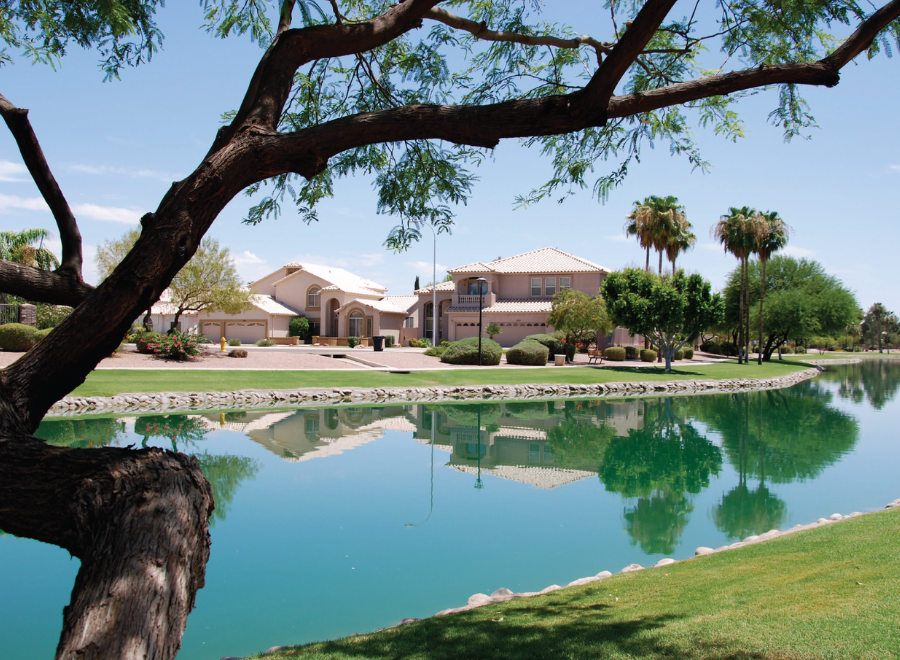Five children hang over the dock at a marina in Lake Mead, a few kilometres north of the Hoover Dam at the southeastern tip of Nevada. Under the torturous desert sun, the kids toss crumbs from a bag of potato chips into the shallow water, attracting the attention of a writhing mass of carp — despite a sign imploring visitors not to harass the marine life.
According to some predictions, scenes like this may become a thing of the past. Three years ago, a controversial study warned that Lake Mead could go dry in a little more than a decade. Last year, amid one of the longest droughts ever in the U.S. Southwest, water levels in the lake dropped to their lowest point since the reservoir was constructed on the Colorado River in the 1930s. Formerly submerged rocks are now small islands, creating obstacle courses for recreational boaters. Boat-launching sites have closed and marina operators have poured millions into new docks as they chase the receding water.
You may unsubscribe from any of our newsletters at any time.
But it’s not just the recreational bathers, boaters and mischievous preteens whose fun is at risk; dwindling water supplies threaten the lifestyles of millions of sun seekers who have settled in the Southwest in the past 25 years, making it the fastest-growing region in the United States. The arid climate is the region’s biggest attraction and its greatest curse. From our water-rich vantage point to the north, we Canadians have long worried that the curse of the U.S. Southwest could become our curse as well. Do dwindling supplies of water in the United States add up to a growing demand for water from Canada? Some prominent activists think so and warn against the impact of bulk water exports.
“It’s the wrong path environmentally, it’s the wrong path economically and it’s going back to a Canada that builds its future based on its natural resources,” says author and activist Maude Barlow, the national chairperson of the Council of Canadians, a left-wing advocacy group.
In theory, Canada could export water for humanitarian relief when severe droughts occur. But Barlow doubts Canada’s fresh water would go to those in greatest need. “I could see the first shipments going to Las Vegas or Los Angeles and Texas and not to the children who are dying in Latin America or in Africa,” she laments. “When you have these monster houses in the desert with three-car garages and swimming pools and golf courses and huge lawns, it’s crazy; it’s not sustainable. Water exports of the kind that have been talked about in this country for years would go to sustain that lifestyle.”
On the opposite side of the equation, business leaders look at the parched Southwest and see an opportunity to generate billions of dollars for our Canadian economy and thousands of new jobs. Abundant fresh water is part of our national identity, and any debate about what to do with it is certain to touch off strong reactions. Making the right choices for the future means setting aside emotion and considering the realities of today.
That’s why I’m driving around the sandy outskirts of Yuma, Ariz., with John Boelts on a blazing afternoon in late July. The thermometer on the dash of Boelts’s colossal Dodge pickup reads 112 F (44 C). Hulking desert mountains loom on the horizon.
Boelts is a 32-year-old farmer— a seemingly incongruous occupation in a region that receives an average of only 8.6 centimetres of rain a year. Yuma, a town of about 70,000 people on Arizona’s southwestern corner, is just a few minutes’ drive from both Mexico and California. Given the lack of rain, it’s miraculous that anything sprouts here. But cotton, some grasses for animal feed, citrus and dates, among other crops, are growing now, fed with water that’s channelled in from the Colorado River. Many plots lie fallow, though, as farmers anticipate Yuma’s more productive growing season. “This is our slower time,” Boelts explains, “wintertime being our big push, requiring the most effort and time.”
He’s not kidding. It is the region’s wintertime output that has garnered Yuma the moniker “Winter Lettuce Capital of the World.” If you eat your lettuce, broccoli, spinach or cauliflower out of season, odds are Yuma produce regularly crosses your lips. Boelts himself sells to distributors that supply lettuce to major restaurant chains that dot North America. And he says demand for vegetables from the region and fresh produce in general is only increasing. “It seems like people are becoming more health conscious, even in the United States. Vegetable consumption, even by USDA’s statistics, per capita consumption is expected to rise,” he says. This is a development that he and the distributors he supplies are betting on in a big way: “The produce companies that, in this area, we all grow produce for . . . have invested millions of dollars in cooling facilities and shipping and processing facilities, a lot of which are being based here.”
Herein lies the fallacy of the accusation that luxury hotels, verdant golf courses and sprawling suburbs are the root of the Southwest’s water problem: proportionately, they use only 20 percent of Arizona’s water. Seventy-five percent goes toward agricultural production, most of which is concentrated in the Yuma area. Canadians, with our year-round appetite for fresh fruit and veggies, are complicit in the high rates of consumption. By irrigating crops and shipping the spoils north, American farmers are meeting our demands. In effect, they’re exporting water from their country’s most water-stressed regions — to us.
Gwyn Morgan, the founding CEO of Encana, one of North America’s largest natural gas firms, thinks he knows why Canadians are so touchy about their fresh water. “When you say ‘bulk water exports,’ it doesn’t matter what the facts are, because it’s something we’re naturally supposed to oppose,” he says, pointing out Canadians have taken much less issue with the export of the country’s oil and natural gas.
Indeed, two small but serious proposals for bulk water exports to the United States popped up in the 1990s: one in British Columbia and the other in Newfoundland. Public outcry scuttled both sets of plans. And the right-wing Frontier Centre for Public Policy think-tank suggested a pipeline from Manitoba to Texas that, it said, could create annual net revenues of more than $8 billion for the province. That submission quickly fell into obscurity.
But Morgan argues that Canadians should be more open to the idea of bulk water exports: “The issue here, of course, is it’s an enormous resource, it’s renewable and it’s actually flowing into the ocean. And it could create lots of jobs and economic advantage for Canada.”
Not surprisingly, Maude Barlow’s position reflects the “Hands off!” refrain on bulk water exports that has been dominant in Canada for the past 20 years. Bulk water exports would be environmentally catastrophic, she says, because our largest reserves of renewable water are in Canada’s most remote regions and would require enormous work projects to move the water south.
This may appear counterintuitive: many Canadians assume water exports mean draining our largest reserves in the Great Lakes and the St. Lawrence River. But those waterways are off the table because they supply one of the most densely populated, industrialized corridors in North America.
That leaves Canada’s mighty northern rivers— like the Mackenzie, the country’s longest river and second largest by discharge volume— which empty into Arctic and Subarctic seas, as th ebest candidates for exploitation. “The only way to get at that water would be to reverse the flow of it through pipeline diversion, through huge engineering feats the sizeof [China’s] Three Gorges Dam, which would massively displace the wilderness, the lives and livelihoods of the First Nations people who live there, the wildlife and so on,” warns Barlow.
Furthermore, Barlow argues that Canada’s water should be viewed as a public asset for all Canadians and says that selling it for private benefit sets a bad precedent and could lead to service cuts, unfair rate hikes or both. “[Corporations] still have to find a way to make that 10 to 15 percent return to pay the great big salaries of their CEOs and dividends to their stockholders. You’re taking something that people need for life and saying, ‘We’re going to use it in a for-profit business, and we have to wring excess profits from it.’ Something is going to have to give.”
Perhaps Barlow’s most compelling — and pragmatic — argument is the notion that if Canada were to allow the practice even once, we may lose sovereignty over water. Because of the rules set out by the North American Free Trade Agreement (NAFTA), bulk water exports could be a kind of Pandora’s Box: once we agree to sell our water to the United States, we may lose the ability to turn off the tap if we discover that shipping our liquid bounty south is more damaging to our ecology than we had bargained for.
Gus Van Harten, an associate professor at Osgoode Hall Law School in Toronto, explains. “If you allow bulk water exports, you can’t really limit it to Canadian companies,” he says, citing NAFTA. If a Canadian company were allowed to start up “even a small operation,” the federal and provincial governments would have to be equally open to proposals from American or Mexican firms. Similarly, if the federal government were to allow Canadian companies to invest in bulk water exports, it would have to provide “no less favourable treatment to American or Mexican investors,” he says.
Furthermore, if federal and provincial governments then changed their minds about bulk water exports and decided to suspend the industry, NAFTA gives corporations the right to sue for lost investments. “And that’s not simply limited to the cost or amount of investment that was committed, but . . . typically requires compensation for lost opportunity for revenue,” Van Harten continues. “I don’t think there can be any doubt that a decision to open up Canadian bulk water to export by private companies, which would have to include U.S. companies, would be difficult and costly to ever reverse.” But Encana’s Gwyn Morgan counters this concern by suggesting that Canadians, and by extension, their governments, would never need to change their minds. “If you’re exporting water that you can’t and won’t use for your own domestic purposes because it’s flowing into the ocean,” he says, “what possible situation could ever arise where there was such a huge problem that you’d want to stop doing it?”
Whether you are for or against bulk water exports, Canadians have good reason to be circumspect. But need we fret in the near term? Asked whether he knows of any serious, active proposals to ship off Canadian water, Morgan said, “It’s been discussed, but I haven’t seen any on the table.” And the Council of Canadians? For all of its anti-export campaigning, the advocacy group says it is not aware of any either.
Aside from outlandish pipeline projects put forward by right-wing think-tanks — whose contributions function mostly as ideological volleys, not viable suggestions — it’s tough to find any evidence that Americans are going to sap us of vast quantities of water in the foreseeable future. Perhaps the simplest, most sensible explanation for the dearth of export proposals is that the demand for Canadian water in the United States just isn’t there. To test this theory, I called around.
At the Bureau of Reclamation, the U.S. government agency that manages the Colorado River, employees are toiling to complete a study that will include a 50-year outlook for the river. Steven Hvinden, chief of operations at the bureau’s Boulder Canyon office, says Canadian water does not figure into their planning.
At the Central Arizona Project, the authority whose network of canals and pipelines carries Colorado River water to much of the state’s population, general manager David Modeer stresses that importing water from Canada “has a very low likelihood of occurring.” (There is talk about channelling seasonal floodwaters from the robust Mississippi River to the headwaters of the Colorado, but Modeer doubts a project of that scale will be implemented in the next 50 years, if at all.) Water managers from the Metropolitan Water District, which serves 19-million consumers in California, including the populations of Los Angeles and San Diego, make similar assertions. As does the Southern Nevada Water Authority: “We have not and are not talking about diverting water from Canada,” says division manager Bruce Moore. “That isn’t on the radar screen.”
It’s 7.30 a.m. on the day after I rode shotgun with farmer John Boelts. The sun, though fully risen, is only hinting at the scorching it has in store. This explains why June Wolfe, a spokesperson for the Bureau of Reclamation, arranged to show me around the Yuma Desalting Plant at such a fresh hour. The YDP is located on the dusty edge of town. Its purpose: to turn brackish groundwater and agricultural runoff into fresh water, using a technology called reverse osmosis.
Essentially, water runs through cellulose acetate membranes in what look like giant canisters. The membranes remove salty brine from the desirable stuff, and the waste is returned to an agricultural drainage canal.
Wolfe gives me a white hard hat to wear before we venture out to the government-built facility. The largest desalination plant in the United States, the YDP has lain dormant for most of the 19 years since its completion.
As we tour the grounds, Wolfe offers me a crash course in the YDP’s recent history. With funding from several local water authorities, the Bureau of Reclamation woke the sleeping giant in May 2010 to undergo a year-long trial run, she says. The municipal utilities wanted to investigate whether the plant could help to alleviate future water shortages. Operating at one-third of its capacity, the plant recycled 30,000 acre-feet of water (one acre-foot is about equivalent to one NFL football field, filled with one foot of water), enough to supply the usage of about 116,000 Americans for one year. However, the YDP didn’t pipe its yield to municipal consumers; the desalinated water flowed downstream to Mexico and counted toward the 1.5 million acre-feet per year of Colorado River water the United States is required to send to its southern neighbour.
A widely used technology in the Middle East and Australia, desalination promises to play a larger role in the way residents of the U.S. Southwest get their water. Smaller facilities have popped up in Florida, Texas and California, with more on the way. Modeer says the United States is even in talks to build plants in Mexico that would fill demand for both countries.
Desalination, Modeer stresses, is no magic bullet. Plants are costly to build and maintain, require immense amounts of energy to run and aren’t without their negative environmental impacts. But the technology represents one tool in a growing arsenal from which water managers will be able to draw.
Modeer spouts off other measures Arizona has been taking to conserve water: mandating high-efficiency fixtures in new homes; educating the public to reduce consumption; retrofitting canals to minimize seepage; and banking water in underground aquifers. “To date, we’ve stored a bit over four million acre-feet in the ground.” He estimates this measure alone could take “the full brunt of the shortages” for 15 years.
On the supply front, Modeer suggests municipalities may resort to buying from agricultural users (who, by law, have first rights to water from he Colorado River before it can be accessed by municipalities). The that options comes at a steep price. “Ag-to-urban” transfers, he figures, will cost between $3,000 and $5,000 per acre-foot. By contrast, the same amount of Colorado River water costs municipalities about$150. Unsurprisingly, these transfers would translate into startling rate increases for the residentsof Phoenix and Tucson, whose household water bills currently average a paltry $25 a month.
Regardless of whether they are successful, Americans are putting money, time and talent into bracing for future water shortages — a fact that is notably absent from the Canadian discussion of bulk water exports. The presumption that Americans are incapable or unwilling to change reflects our chronic underestimation of our neighbours to the south and, crucially, our overestimation of their readiness to pay handsomely for water.
Hence, the best incentive for U.S. consumers of water to conserve may be economics — simple supply and demand. Perhaps, ironically, it’s here that the Canadian left may have found its great, unexpected ally.
***
This story first appeared in The United Church Observer’s October 2011 issue with the title “Water for sale?”















